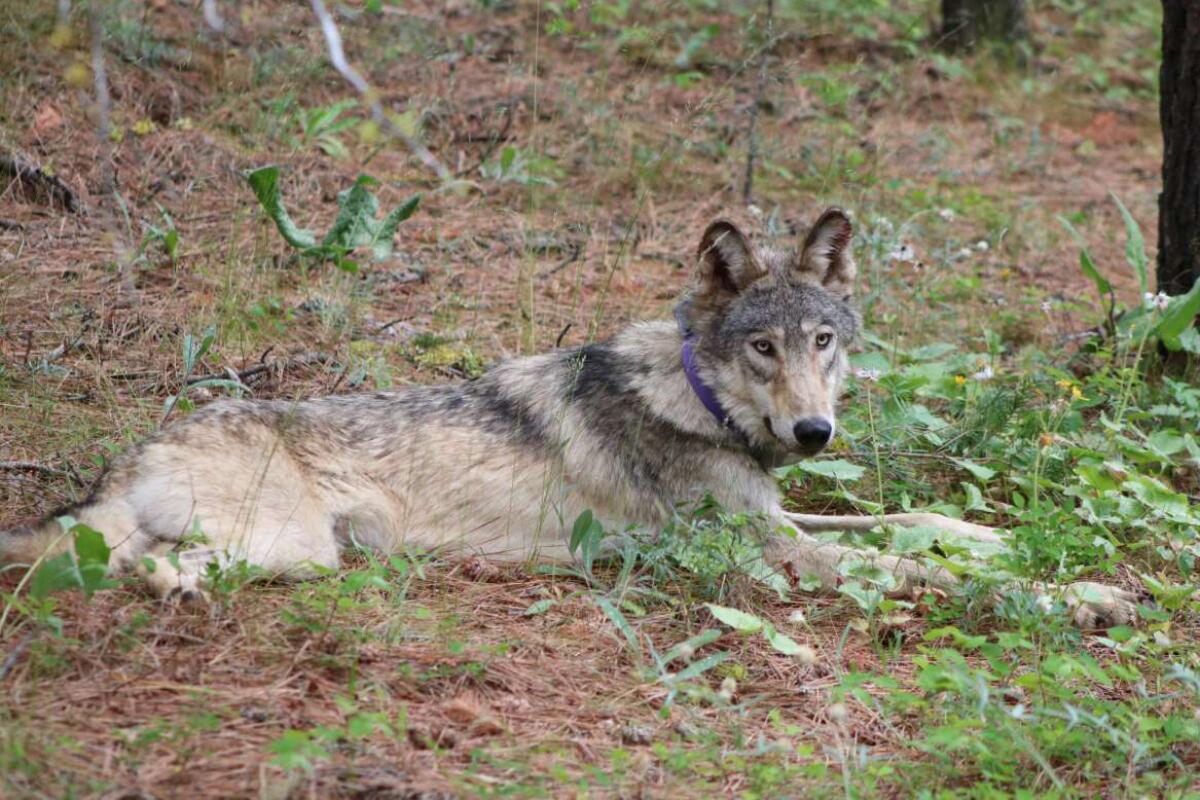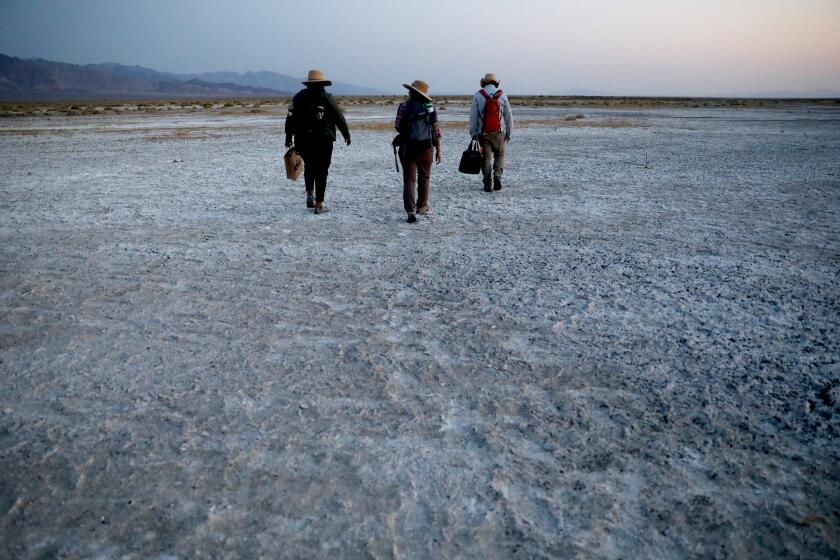The epic journey of gray wolf OR-93 comes to a tragic end near I-5

- Share via
Wolf advocates across the nation were brooding over the bad news this week: The epic journey of a lone gray wolf that ventured from Oregon to the very edge of Southern California’s crowded suburbs in search of territory and female mates had ended in a vehicle collision near Interstate 5 in the Kern County town of Lebec.
“OR-93’s relentless wandering gave us hope, inspiration and a brief glimpse at what it would be like to see wolves running free across California again,” said Amaroq Weiss, a spokeswoman for the Center for Biological Diversity. “I only wish we could have offered him a safer world.”
California’s most adventurous wolf was found dead on the afternoon of Nov. 10 by a truck driver who noticed the carcass on a dirt trail near a frontage road running parallel to Interstate 5, officials said. A state game warden collected the remains, which were transported to the Wildlife Health Laboratory in Rancho Cordova, Calif., where the necropsy was performed.
A necropsy conducted on the carcass, which was found roughly 50 miles north of Los Angeles, determined that OR-93 had suffered “significant tissue trauma to the left rear leg, a dislocated knee and soft tissue trauma to the abdomen,” the California Department of Fish and Wildlife said Wednesday. The agency also said it “determined the wolf died from trauma consistent with vehicle strike and does not suspect foul play.”
As a gray wolf known as OR-93 heads deeper into California, his journey grows ever more perilous.
Pushed by an evolutionary gamble to pass off his genetic information to new generations of wolves in a region where they had not been seen for more than 200 years, OR-93’s record-breaking travels in California had signaled the potential return of a predatory force that some conservationists hoped would repair out-of-balance wildlands and make them more stable and diverse.
But it also increased the odds that OR-93 would wander into trouble on highways, in suburbs or on ranchlands where he might be mistaken for an unusually large coyote and trapped and shot as a threat to livestock.
Weiss was among wolf advocates and wolf haters alike who had been keeping their eyes peeled for an unusually large canine predator on the prowl since biologists lost track of the “pings” emitted by OR-93’s purple radio collar on April 5 in San Luis Obispo County, about a three-hour drive north of Los Angeles.
By then, state wildlife officials said, he had traveled at least 935 air miles in California, a minimum average of 16 miles per day.
Deepening the mystery was the fact that officials had not picked up a “mortality signal” from the collar, which would indicate the beast had stopped moving.
As the Earth warms and the drought deepens, a network of biologists and conservationists are racing to rescue California’s most threatened species.
Only a week ago, Weiss hiked across a swath of wilderness in the Los Padres National Forest near where a landowner’s trail camera recorded video footage of the wolf near a water trough in May.
“I immerse myself in that landscape, searching for scat, tracks — any clues that OR-93 was still on the move,” she said. “I didn’t find any. But I didn’t give up hope because that area is packed with deer and has plenty of room to roam.”
OR-93 was just over a year old when biologists outfitted him with a GPS tracking collar near where he was born, south of Mt. Hood in western Oregon.
On Jan. 30, he left his pack and headed south, traveling swiftly and leaving a scented trail past Northern California lava beds, over snowy passes in the Sierra Nevada, along the outskirts of Yosemite National Park, and into an agricultural area near Fresno.
From there, he headed west toward the Central Coast, successfully crossing the 99, 5 and 101 freeways — three of the most perilous roads in the nation.
The GPS collar gave Oregon Department of Fish and Wildlife biologists a few downloads of data about its location each day that were shared with California wildlife authorities.
In California, wildlife authorities were reluctant to reveal details about the wolf’s precise location out of fear that it might make it easier for hunters to track him down and kill him.
The California Cattlemen’s Assn., which had been keeping track of the wolf’s progress in weekly bulletins, decided not to announce that OR-93’s radio collar had gone silent. Association officials said at the time that the fact that OR-93’s radio collar had quit emitting signals didn’t necessarily mean that the wolf wasn’t still prowling the area in search of a meal.
The fewer than two dozen wolves believed to be currently living in Northern California include the Lassen pack, whose territory covers portions of Plumas and Lassen counties; the Beckwourth pack in eastern Plumas County; and the Whaleback pack, in eastern Siskiyou County. Then there’s OR-103, another lone male who crossed into Northern California on May 4.
Before they were vanquished by government-backed poison-and-trapping campaigns, millions of wolves thrived in nearly every region of North America. Today, only about 6,000 are left in the Lower 48, and as many as 12,000 in Alaska, where they are legally hunted as big game.
Gray wolves were removed from the federal endangered species list a year ago after the U.S. Fish and Wildlife Service determined the overall population was “stable and healthy throughout its current range.”
Since then, Idaho and Montana have passed new laws to drastically reduce wolf populations in those states. Environmental groups including the Center for Biological Diversity responded with lawsuits that challenged the delisting, calling it premature and unscientific.
Pamela Flick, California program director with Defenders of Wildlife, said OR-93’s “unfortunate demise along Interstate 5 underscores the need for more wildlife crossing structures throughout the state to facilitate safe passage for animals and increase safety for humans.”
Beth Pratt, regional executive director of the nonprofit National Wildlife Federation and leader of its #SaveLACougars campaign to fund a wildlife crossing over a 10-lane stretch of the 101 Freeway in the Santa Monica Mountains, could not agree more.
“I had to take a long walk after I heard the painful news that OR-93’s wanderings were over,” she said. “At one point, he passed within 15 miles of my home near Yosemite National Park — and after that I posted a sign in my driveway: ‘Wolves are back!’
“What hurts deep down inside,” she added, “is that OR-93 was only steps away from the 270,000-acre Tejon Ranch Conservancy when he was run over.
“A few feet away was a Shangri-La for wolves just waiting for him and an adventurous female to follow his path into the history books.”
More to Read
Sign up for Essential California
The most important California stories and recommendations in your inbox every morning.
You may occasionally receive promotional content from the Los Angeles Times.












